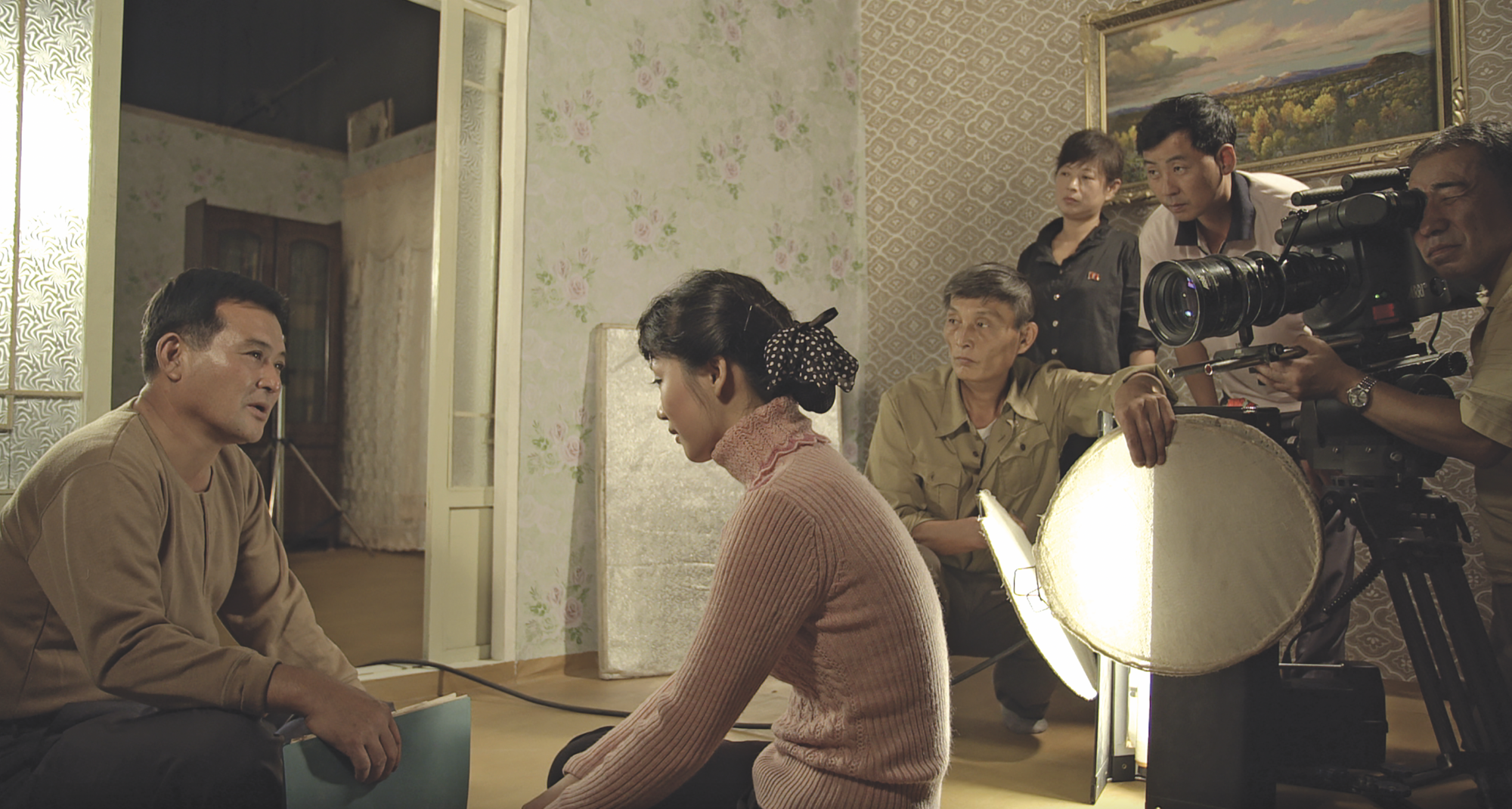Whether they be mesmerising athletes or emblematic traffic conductors, graceful goose-stepping soldiers or meticulous ‘model workers’, women in North Korea have arguably received more attention in cultural expressions than their sisters in the ‘free world’. As cogs in the machinery of Pyongyang’s mission to promote the Great Leaders and the Party, women are primarily depicted across various media as agents of ideological change. The oscillation between representations of women in the past and the present – between domestic tradition and public revolution – is one of the most enduring aspects of the country’s films, and it is the opaqueness between these representational boundaries that makes North Korean cinema all the more compelling.
While it has long been official policy in North Korea to bridge the gender gap, the propagandist fervour underpinning even the subtlest of cinematic offerings has been arguably geared more towards nationalism and the cult-personality construction of the country’s leaders than towards women’s rights. As writer Paul Fischer notes, Kim Jong Il was his father’s publicity guru, venerating him as a hero and a saint.[1]Paul Fischer, A Kim Jong-Il Production: Kidnap. Torture. Murder … Making Movies North Korean Style, Penguin, London, 2016, p. 61. Although Kim Il Sung was rarely portrayed in films as the lead protagonist, his position as Supreme Leader would catapult him into the mythological realm in just under a quarter of a century. In North Korean cinema, as in North Korean life, the grand patriarch is ever present, with women mostly serving as decorative tools to assist men in accomplishing the objectives of the revolution.
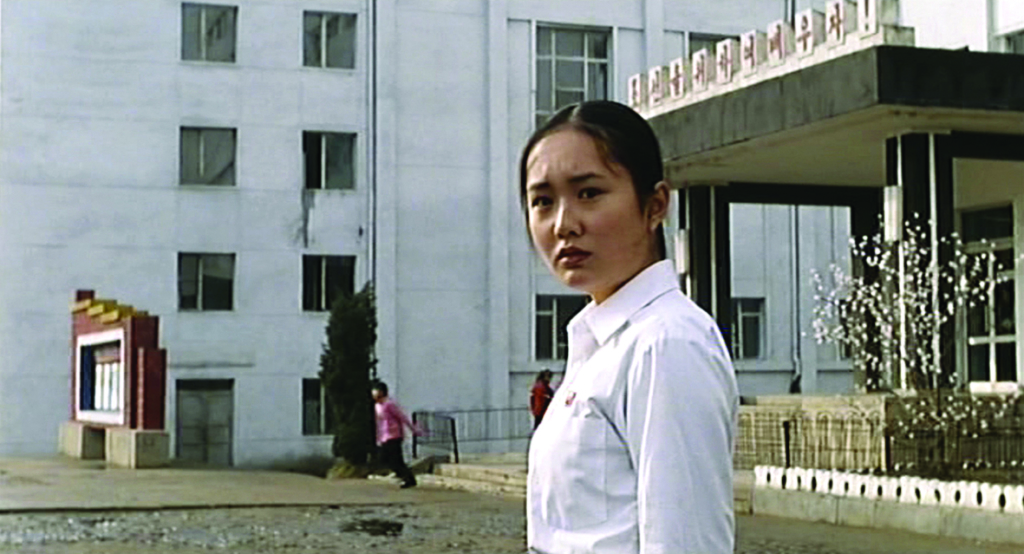
Revolutionary muse: The Flower Girl
It would take a woman – or, rather, a beatific-faced teenager – to cement Kim Il Sung’s place in the public consciousness as the Great Liberator. Allegedly written by Kim Il Sung while a Japanese prisoner during the 1930s, the revolutionary theatrical opera The Flower Girl (dubbed ‘the immortal classic’) was adapted to film by Choe Ik Kyu and Pak Hak in 1972, a project overseen by an eager-to-please Kim Jong Il. The film tells the story of Kotpun (Hong Yong Hui), a rural girl living under the economic hardship of Japanese occupation, who sells wild azaleas to buy medicine for her desperately ailing mother. With their father dead and their brother imprisoned, Kotpun and her blind sister struggle to make ends meet despite the gnawing absence of a male provider and protector. Just as Kotpun is about to give up hope, her liberated brother makes a return with Kim Il Sung’s Korean Liberation Army in tow to defeat the Japanese imperialists and their collaborators.
Imbued with the hot flush of revolutionary pride, Kotpun then walks through the town bearing bouquets of azaleas with the crafted addition of peonies, symbolising family honour, prosperity and the prospect of a happy marriage. No longer is her domestic life complicated by isolating poverty and physical exploitation; as legions of women like her join the revolutionary cause, public space becomes the only legitimate place to invest collective energy in the reconstruction of society and nation. That place, of course, is subordinate to the state patriarch and the party, as can be denoted in the final scene, in which Kotpun receives her revolutionary training from her liberated brother and his male comrades.
Yong Mi hardly cuts a figure of rebellion in her determination to realise her passion … As with Kotpun and all other North Korean celluloid female protagonists, Yong Mi’s fate lies firmly in the hands of men.
Yet so iconic is the image of the flower-bearing Kotpun that her place within the cultural landscape of North Korea is strongly reminiscent of that of a fertility goddess, personifying the abstract powers of rebirth and regeneration. As she sets her eyes on the horizon, a close-up of Kotpun’s high-cheekboned, oval-shaped face captures the moment of her political awakening, channelling a quintessential revolutionary spirit through her delicate beauty and sexuality.
Materialistic desires: A Schoolgirl’s Diary
In 2006, A Schoolgirl’s Diary, directed by Jang In Hak, premiered at the Pyongyang International Film Festival, becoming the first North Korean feature film in decades to pick up an international distributor. More importantly, it was also a rare North Korean film that departs from pathological anti-Americanism, instead delving into the ordinary lives of two sisters in a lighthearted attempt to reveal the social problems associated with capitalism. Su Ryeon (Pak Mi Hyang) feels neglected by her father, San Myeong (Kim Cheol), and humiliated by his lack of professional success. She dreams of living in an apartment in Pyongyang, as do a few of her acquaintances whose fathers’ achievements have been officially recognised by the Party.
When Su Ryeon realises that her scientist-father has committed his whole life to the Dear Leader, Kim Jong Il, she feels inspired to pursue her studies in science as a way to contribute further to her country’s success. While the film falls back on the familiar trope of the paternal saviour, the arc of a character wrestling with materialistic desires is refreshingly dealt with, in a narrative that, within the broader context of North Korean cinema, feels almost modern.
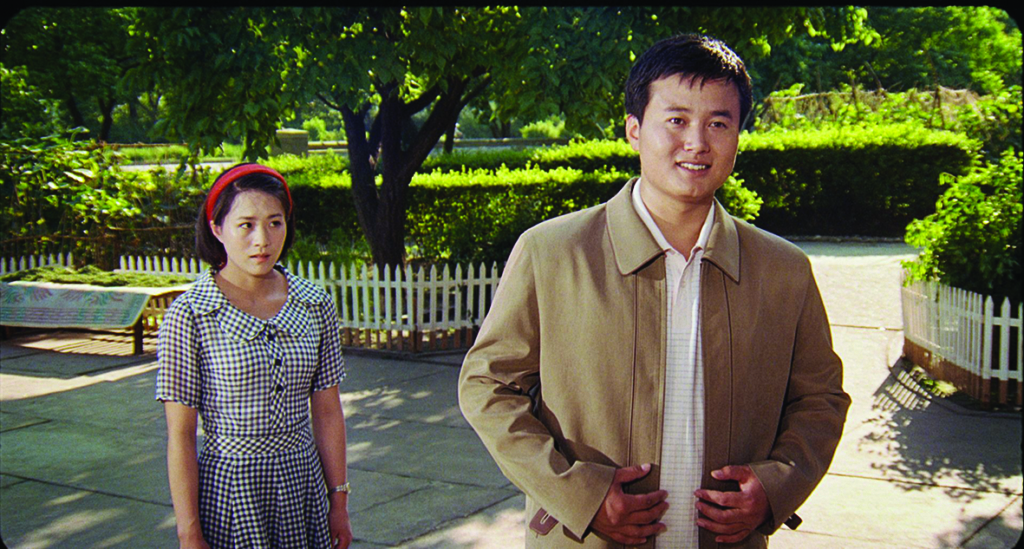
Individual dreams: Comrade Kim Goes Flying
The themes underpinning A Schoolgirl’s Diary would drive another work concerned with individualistic desires: Comrade Kim Goes Flying (2012). Co-directed by an international troika – North Korean director Kim Gwang Hun, UK national (and co-founder of Koryo Tours) Nick Bonner and Belgian producer Anja Daelemans – the film challenges the nation’s reputation as the world’s most oppressive regime by showing a technicolour worker’s paradise in which individual dreams do come true. Comrade Kim Yong Mi (Han Jong Sim) is a much-loved 28-year-old coalminer with a megawatt smile who aspires to become a trapeze artist. When her outstanding work record allows her to transfer from her countryside coalmine unit to a construction brigade in Pyongyang, Yong Mi has a chance encounter with her heroine, famous trapeze artist Ri Su Yon (Kim Un Yong), which leads her to audition for the prestigious national circus.
Comrade Kim Goes Flying hits a number of firsts. The first jointly funded Western – North Korean feature film shot entirely in North Korea with an all-Korean cast, Comrade Kim Goes Flying was additionally the first North Korean film screened in more than a decade in South Korea, appearing at the 2012 Busan International Film Festival. The feel-good comedy would go on to be shown at various international film festivals, achieving a kind of cult status as a socialist rite-of-passage fairytale. According to Bonner, the film was also the first to break away from the overtly propagandist tradition of Kim Jong Il’s deification-charged cinema, with the primary goal to entertain rather than educate[2]Greg Iacurci, ‘North Korea Girl Goes “Girl Power”: Co-director Nick Bonner on His New Film Comrade Kim Goes Flying’, GALO, 19 July 2013, <http://www.galomagazine.com/movies-tv/north-korea-goes-girl-power-co-director-nick-bonner-on-his-new-film-comrade-kim-goes-flying>, accessed 9 August 2018. – a welcome change in a land where the latest Chinese and South Korean movies are increasingly exchanged on the black market,[3]Danny Hajek, ‘Watching Foreign Movies Is Illegal in North Korea, but Some Do It Anyway’, NPR, 5 July 2017, <https://www.npr.org/2017/07/05/534742750/watching-foreign-movies-is-illegal-in-north-korea-but-plenty-do-it-anyway>, accessed 27 August 2018. altering North Koreans’ tastes and attitudes towards their homegrown cinema.
Broinowski’s overarching theme becomes clear: film artists – be they male or female, whether living in the most open or the most isolated of societies – are a family united in their quest to tell unique stories and effect change.
As a garlanded model worker, Yong Mi is an altogether-different kind of flower girl from the azalea-picking Kotpun, whose livelihood largely depends on the revolutionary awakening, ideals and strength of the nation’s young men. Living in the worker’s paradise Kotpun could only dream of, Yong Mi has the luxury to pursue her dream, which is immediately shown to be at odds with the general international perception of North Korea as an ultra-repressive, patriarchal society in which individual desires are suppressed for the good of the greater collective.
Yet Yong Mi hardly cuts a figure of rebellion in her determination to realise her passion, and is just as happy to perform for her awestruck coalmining comrades on the train home at the end of a long day. Despite being outmatched by the male workers’ physical strength at the construction site, she challenges three male colleagues to an arm wrestle, in the hope that her charm will encourage them to build her the equipment necessary for the workers’ acrobatic festival. They let her win not only because they recognise the purity of her intentions, but also because she embodies the wider aspirations of the work unit – who, under her guidance and unbridled talent, look set to receive accolades for their participation in the festival for the first time ever.

As with Kotpun and all other North Korean celluloid female protagonists, Yong Mi’s fate lies firmly in the hands of men. From her father (Kim Son Nam), who reluctantly permits her to return to Pyongyang for the final trials, and her love interest, Pak Jang Phil (Pak Chung Guk), the nation’s top trapeze artist who initially shows her contempt, to the influential male judges and amorously stirred younger male colleagues in her work unit, Yong Mi still has to negotiate the public sphere of a deeply ingrained patriarchal society. But this discordance is more subtly conveyed in this film due to its rom-com treatment, which serves to emphasise the North Korean sense of humour rather than offer explicit social commentary on gender relations.
Family united: Aim High in Creation!
The somewhat-unexpected fact that such a strong comedic sensibility exists in the country is something Australian director Anna Broinowski quickly discovered when making Aim High in Creation! (2013). For this work, Kim Jong Il’s 1973 treatise On the Art of the Cinema – which, the story goes, was given to Broinowski by a friend as a joke – formed the basis of a groundbreaking experiment: a short propaganda film made with the intention of stopping a mine being built near her inner-city Sydney home, shot according to the six principles outlined by Kim Jong Il in his manifesto.[4]Chris Evans, ‘Australian Filmmaker Anna Broinowski Explores the Movie Mania of North Korea’, The Australian, 29 June 2013, <https://www.theaustralian.com.au/arts/review/australian-filmmaker-anna-broinowski-explores-the-movie-mania-of-north-korea/news-story/2d5c1d0946894eeca4d4936899c9fd25>, accessed 17 August 2018. As the first Western director to gain full access to the North Korean film industry, Broinowski sought advice from the great masters of propaganda filmmaking on how to approach her own film, a process that developed into an insightful, hilarious feature-length documentary about her twenty-one-day apprenticeship inside the ‘hermit kingdom’.
From the very beginning of Aim High in Creation!, Broinowski stands firm on her opinion that Kim Jong Il was a ‘cinematic genius’, admiring, among other things, the strength of the female characters in the films he oversaw – in direct contrast to Western films, wherein women are still grossly under-represented or haplessly confined to offensive stereotypes. To reiterate her point, Broinowski splices North Korean heroines into her work largely for the benefit of Western audiences who may be unfamiliar with the strong female leads that define the country’s film output. Under the North Koreans’ appraisal, Broinowski’s script incorporates the tropes of revolutionary cinema: the lead, Karen (Susan Prior), is the archetypal heroic worker who, with her daughter, Sally (Kathryn Beck), and noble husband, Al (Elliott Weston), is tasked with overthrowing the evil gas miners, Riccard (Peter O’Brien) and Mitch (Matt Zeremes), in order to save their inner-city public park.
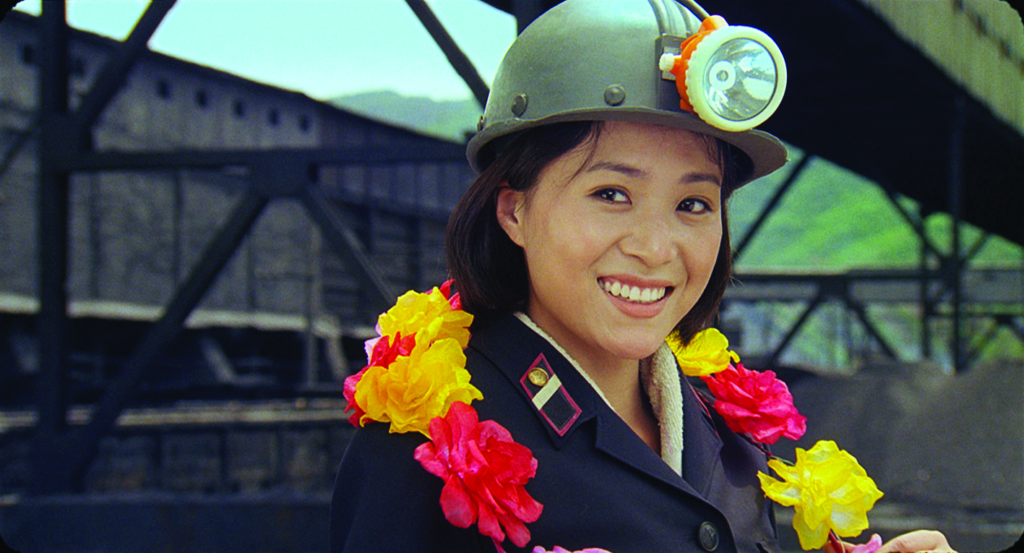
While the end result is a surreal spoof on revolutionary cinema – largely because of its inability to translate into a contemporary Australian context – it remains a quintessential Australian film for all its hallmark quirkiness. Above all, it works as an exemplary form of ‘soft power’, in which our preferences as audience members are shaped by our attraction to the genuinely unfamiliar and unexpected. In this way, Broinowski’s role as a director can be likened to that of an ambassador as she guides her cast, audience and North Korean mentors into a space where differences are blurred and an unwavering code of honour emerges among like-minded film folk.
Her position as a female director is also unexpectedly lauded by the North Koreans – firstly by an unnamed female film comrade, then later by director Pak Jong Ju, who develops an achingly paternalistic admiration for his eager student: ‘I will come out of my tomb to help you make your movie,’ he declares. Though this astonishing new bond once again conforms to the ingrained view of the man as head and as chief decision-maker, it is their shared passion for film that levels the ground for mutual inquiry.
The film concludes with the filmmaker expressing her disappointment that her short propaganda film didn’t put an end to the fracking along the eastern seaboard, though we learn that it was ‘people power’ that ultimately stopped the fracking mine in Sydney. Broinowski’s over-arching theme becomes clear: film artists – be they male or female, whether living in the most open or the most isolated of societies – are a family united in their quest to tell unique stories and effect change. There are, as Pak acknowledges early on in their meeting, more similarities than differences.
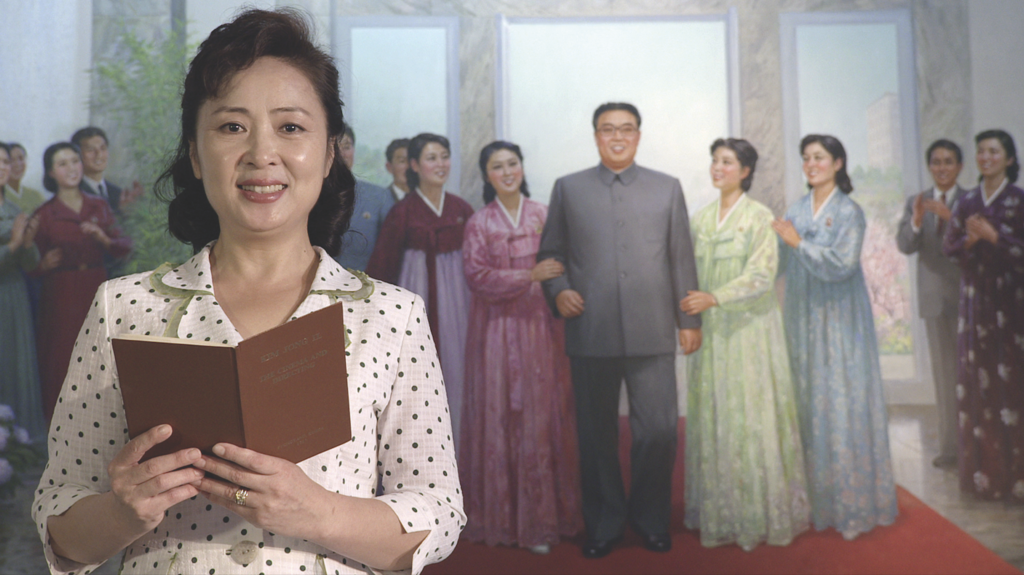
Until the death of Kim Jong Il in December 2011, cinema was the main vehicle driving the country’s Juche ideology, which centres on self-reliance and stresses that the masters of revolution and construction are the masses.[5]Kim Jong Il, On the Art of the Cinema, English edn, Foreign Languages Publishing House, Pyongyang, 1989 [1973], p. 9; see also ‘Juche Ideology’, Democratic People’s Republic of Korea official website, <http://www.korea-dpr.com/juche_ideology.html>, accessed 17 August 2018. Women have long played an affirmative role in reinforcing the national narrative of the Kim family’s supremacy, but, under the new leadership of Kim Jong Un, cinema has become all but a relic of the previous regime. The new leader reportedly favours television sitcoms, which, in contrast to his father’s preferred creative medium, deal with civilian family life and social issues.[6]Adam Taylor, ‘What You Can Learn from Watching North Korean Soap Operas’, The Washington Post, 11 December 2017, <https://www.washingtonpost.com/news/worldviews/wp/2017/12/11/what-you-can-learn-from-watching-north-korean-soap-operas>, accessed 17 August 2018. Set in candy-coloured ‘Pyonghattan’, Our Neighbors, for example, is a North Korean version of Friends that similarly emphasises the importance of family and community in the big smoke. Rather than being objectified as revolutionary muses, the female characters here are reflective of real life rather than a revisionist past. Yet it is this shift in the representation of women that owes a great deal to the much-loved celluloid peonies of Pyongyang.
Endnotes
| 1 | Paul Fischer, A Kim Jong-Il Production: Kidnap. Torture. Murder … Making Movies North Korean Style, Penguin, London, 2016, p. 61. |
|---|---|
| 2 | Greg Iacurci, ‘North Korea Girl Goes “Girl Power”: Co-director Nick Bonner on His New Film Comrade Kim Goes Flying’, GALO, 19 July 2013, <http://www.galomagazine.com/movies-tv/north-korea-goes-girl-power-co-director-nick-bonner-on-his-new-film-comrade-kim-goes-flying>, accessed 9 August 2018. |
| 3 | Danny Hajek, ‘Watching Foreign Movies Is Illegal in North Korea, but Some Do It Anyway’, NPR, 5 July 2017, <https://www.npr.org/2017/07/05/534742750/watching-foreign-movies-is-illegal-in-north-korea-but-plenty-do-it-anyway>, accessed 27 August 2018. |
| 4 | Chris Evans, ‘Australian Filmmaker Anna Broinowski Explores the Movie Mania of North Korea’, The Australian, 29 June 2013, <https://www.theaustralian.com.au/arts/review/australian-filmmaker-anna-broinowski-explores-the-movie-mania-of-north-korea/news-story/2d5c1d0946894eeca4d4936899c9fd25>, accessed 17 August 2018. |
| 5 | Kim Jong Il, On the Art of the Cinema, English edn, Foreign Languages Publishing House, Pyongyang, 1989 [1973], p. 9; see also ‘Juche Ideology’, Democratic People’s Republic of Korea official website, <http://www.korea-dpr.com/juche_ideology.html>, accessed 17 August 2018. |
| 6 | Adam Taylor, ‘What You Can Learn from Watching North Korean Soap Operas’, The Washington Post, 11 December 2017, <https://www.washingtonpost.com/news/worldviews/wp/2017/12/11/what-you-can-learn-from-watching-north-korean-soap-operas>, accessed 17 August 2018. |
